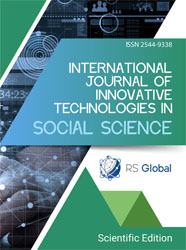NETWORKING AS A COMPONENT OF FORMING SOCIAL CAPITAL: THE ECONOMIC ASPECT
Abstract
The article analyzes the nature and economic importance of social networks as one of the components of social capital. It is shown that the economic component of social capital is associated with the ability to obtain certain economic benefits from its use. Mechanisms for the accumulation of social capital contain the involvement in these processes of all its components - trust, norms, values, social networks. The network approach of J. Coleman to substantiation of economic essence of social capital is analyzed. The necessity, possibility and directions of influence of social networks on formation and increase of efficiency of social capital have been proved. The types of social networks and the possibilities of their influence on creation of connecting, horizontally-integrating and vertically integrating social capital are revealed. The rating of social networks and examples of their use to increase the efficiency of functioning of social capital are given. It is proved that networks are formed not chaotically, but purposefully, given the subjective vision of the feasibility of such interaction, and their use can have both positive and negative consequences. The possibility of using social networks to form a service-oriented state is indicated.
References
Coleman, J. (1990) Foundations of Social Theory. Cambridge MA: Harvard University Press. 1014 p. https://books.google.com.ua/books?id=a4Dl8tiX4b8C&printsec=frontcover&hl=ru&source=gbs_ge_summary_r&cad=0#v=onepage&q&f=false
Ostrom, E. (2000) Social capital: A fad or fundamental concept? // Social Capital: A Multifaceted Perspective / ed. by P. Dasgupta, I. Seragilden. Washington, D.C.: The World Bank, P. 172-214.
Bourdieu, P. The Forms of Capital. Handbook of Theory and Research for the Sociology of Education / in Richardson, John G., ed. New York: Greenwood, 1986. P. 241-258.
Berger P. Lukman T. Social construction of reality M.: MEDIUM, 1995. 323 с. https://evolkov.net/soc.psychol/Berger.P.Luckmann.T/
Miller, N. A. (2012) Osvіtnіy District: osnovnі zavdannya that funktsіі. Narodna Osvita. №3(18).
Castells, M. (2009)The Power of Identity. Information Age: Economy, Society and Culture. Blackwell Publishing, 584 p.
Didyk, L.A. (2018) Spatial Disposition of Communication Agents on Social Networking. THE GRANDS. Volume 21. № 6. SOCIOLOGY p.51-57.
The most popular social networks in the world. Retrieved from https://futurenow.com.ua/21-najpopulyarnishyh-sotsialnyh-merezh-svitu-ta-rejtyngukrayiny/
Roundtable on Network Society: Labor Market, Public Relations, the Role of Trade Unions (Kyiv, APSVT, March 22, 2018). https://www.socosvita.kiev.ua/node/2053
Shadrin A.E. (1999) Network model of organization. Information Society. No. 2. P.86-88. http://emag.iis.ru/arc/infosoc/emag.nsf/BPA/d0b0d7d739149c71c32569e500517ce0
Vilchinskaya I. (2015) Political interactivity. The latest political vocabulary (neologisms, Occasionalism and other innovations). Encyclopedic Dictionary Directory. For the title. ed. NM Khomi. L .: New World-2000.
Masuda Y. (1981) The Informational Society as Postindustrial Society. World Future Society. 165 р. https://books.google.ru/books?id=ynkmIxF1G3AC&pg=PR3&hl=uk&source=gbs_selected_pages&cad=2#v=onepage&q&f=false
Granovetter М. (1983) The Strength of Weak Ties Network Theory. Revisited. Sociological Theory. Vol 1. P. 201-233.
Views:
502
Downloads:
294
Copyright (c) 2020 Zoia Halushka, Nafus Inna

This work is licensed under a Creative Commons Attribution 4.0 International License.
All articles are published in open-access and licensed under a Creative Commons Attribution 4.0 International License (CC BY 4.0). Hence, authors retain copyright to the content of the articles.
CC BY 4.0 License allows content to be copied, adapted, displayed, distributed, re-published or otherwise re-used for any purpose including for adaptation and commercial use provided the content is attributed.











